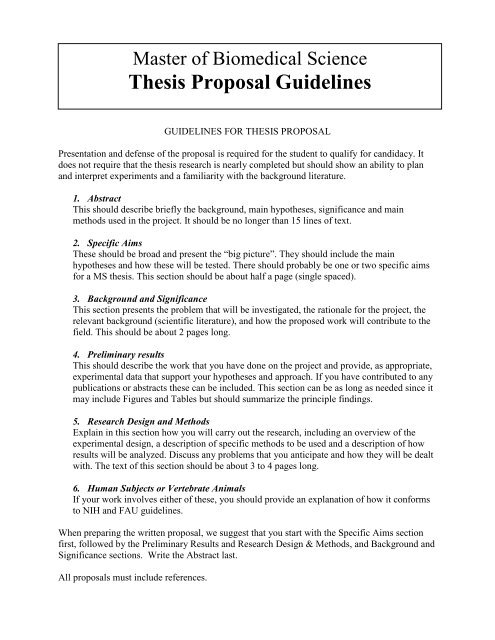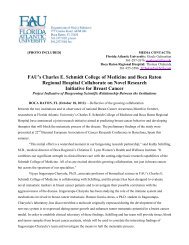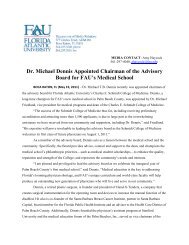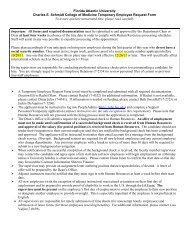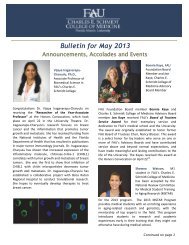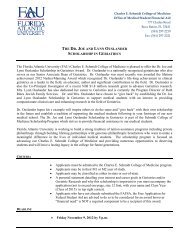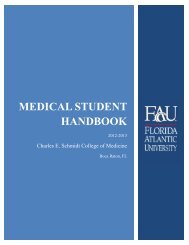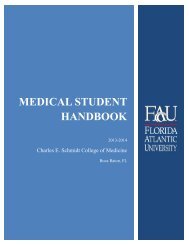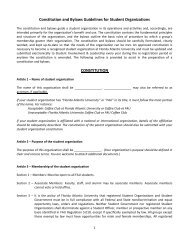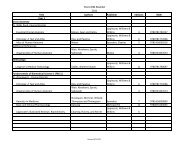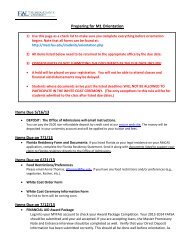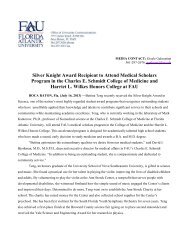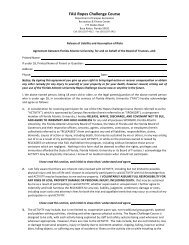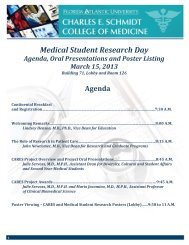Thesis Proposal Guidelines
Thesis Proposal Guidelines
Thesis Proposal Guidelines
Create successful ePaper yourself
Turn your PDF publications into a flip-book with our unique Google optimized e-Paper software.
Master of Biomedical Science<br />
<strong>Thesis</strong> <strong>Proposal</strong> <strong>Guidelines</strong><br />
GUIDELINES FOR THESIS PROPOSAL<br />
Presentation and defense of the proposal is required for the student to qualify for candidacy. It<br />
does not require that the thesis research is nearly completed but should show an ability to plan<br />
and interpret experiments and a familiarity with the background literature.<br />
1. Abstract<br />
This should describe briefly the background, main hypotheses, significance and main<br />
methods used in the project. It should be no longer than 15 lines of text.<br />
2. Specific Aims<br />
These should be broad and present the “big picture”. They should include the main<br />
hypotheses and how these will be tested. There should probably be one or two specific aims<br />
for a MS thesis. This section should be about half a page (single spaced).<br />
3. Background and Significance<br />
This section presents the problem that will be investigated, the rationale for the project, the<br />
relevant background (scientific literature), and how the proposed work will contribute to the<br />
field. This should be about 2 pages long.<br />
4. Preliminary results<br />
This should describe the work that you have done on the project and provide, as appropriate,<br />
experimental data that support your hypotheses and approach. If you have contributed to any<br />
publications or abstracts these can be included. This section can be as long as needed since it<br />
may include Figures and Tables but should summarize the principle findings.<br />
5. Research Design and Methods<br />
Explain in this section how you will carry out the research, including an overview of the<br />
experimental design, a description of specific methods to be used and a description of how<br />
results will be analyzed. Discuss any problems that you anticipate and how they will be dealt<br />
with. The text of this section should be about 3 to 4 pages long.<br />
6. Human Subjects or Vertebrate Animals<br />
If your work involves either of these, you should provide an explanation of how it conforms<br />
to NIH and FAU guidelines.<br />
When preparing the written proposal, we suggest that you start with the Specific Aims section<br />
first, followed by the Preliminary Results and Research Design & Methods, and Background and<br />
Significance sections. Write the Abstract last.<br />
All proposals must include references.
<strong>Thesis</strong> <strong>Proposal</strong> Formatting Requirements:<br />
Font size: 12 point<br />
Margins: 1 inch<br />
Line spacing: single-space<br />
All proposals should adhere to the following format for citations and references:<br />
References<br />
Citation in text<br />
Please ensure that every reference cited in the text is also present in the reference list (and vice versa). Unpublished<br />
results and personal communications are not recommended in the reference list, but may be mentioned in the text. If<br />
these references are included in the reference list they should follow the standard reference style of the journal and<br />
should include a substitution of the publication date with either "Unpublished results" or "Personal communication".<br />
Citation of a reference as "in press" implies that the item has been accepted for publication and a copy of the title<br />
page of the relevant article must be submitted.<br />
Web references<br />
As a minimum, the full URL should be given. Any further information, if known (DOI, author names, dates,<br />
reference to a source publication, etc.), should also be given. Reference to material which is available on the Internet<br />
but has not been published elsewhere should be made in the text only and should not be included in the reference<br />
list.<br />
Reference style<br />
References should be listed at the end of the manuscript. They should be listed in the order in which they appear in<br />
the text, tables, and figure legends and numbered sequentially. When cited in the text, reference numbers should be<br />
superscripted. Only papers that have been published or accepted should be cited in the reference list. The title of the<br />
article, the volume number, and first and last pages should be cited. Journal titles should be abbreviated, e.g.,<br />
1. Sanger, F. & Coulson, A. R. (1975). A rapid method for determining sequences in DNA by the primed synthesis<br />
with DNA polymerase. J. Mol. Biol. 94, 441-448.<br />
2. Goto, Y., Calciano, L. J. & Fink, A. F. (1990). Acid-induced folding of proteins. Proc. Natl. Acad. Sci. USA 87,<br />
573-577. Articles in books should include the title of the article, the name of the book, editor(s), edition number,<br />
first and last page numbers, the name and the location of the publisher, e.g.,<br />
3. Hanks, S. K. & Hunter, T. (1995). The eukaryotic protein kinase superfamily. In The Protein Kinase FactsBook:<br />
Protein-Serine Kinases (Hardie, G. & Hanks, S., eds), pp. 747, Academic Press, London.<br />
Journal abbreviations source<br />
SI units and the system of abbreviations and symbols formulated by the IUPAC-IUB Combined Commission on<br />
Biochemical Nomenclature should be followed. When non-SI units are used, their equivalent SI units should be<br />
given. Genetic names should be described according to the appropriate conventions. Genus and species names<br />
should be written in full at first use and in italics (e.g., Escherichia coli, Caenorhabditis elegans).


